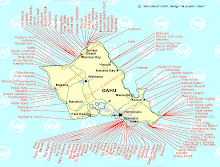Hawaii's Beach and Water Pollution
Hawaii's beaches are being polluted due to runoff and carelessness. Hawaii's residents and tourism rely heavily upon the cleanliness of the beaches. The tourism of foreigners supports the Hawaiian economy; with tourism's driving factor being our clean, pristine beaches. Without tourism the economy of Hawaii would suffer, people would lose their jobs, causing a negative economic trickle-down effect. Pollution also creates problems, economically, because money must be put into creating government organizations for the protection of the oceans and beaches. Especially in times of economic trouble, the importance of spending precious money on creating and supporting organizations to preserve beaches comes into question. Citizens are also contributing, either indirectly or directly, to these government-run organizations because the government uses taxes collected from the citizens of Hawaii to help create the organiztions.
History of the Clean Water Branch in HawaiiHawaii's water pollution control programs began in the late 1960's in the sanitary branch of the Department of Health. This branch included the Water Pollution Control Program, Waste Water Treatment Facility, Construction Grants Program, and the Drinking Water and Swimming Pool Approval Program. It was staffed by engineers and environmental health specialists. In 1973 and 1974 the Hawaii State Legislature formally established the Water Pollution Control Program through Act 100. In 1974 the EPA, Environmental Protection Agency, delegated the administration of the National Pollutant Discharge Elimination System Permit Program in Hawaii to the Department of Health. This national program controls point-source discharges of pollutants to water's of the state through uniform permiting procedures. In 1974 with Act 249 represented Hawaii's initial attempt to address non-point source pollution problems by instructing each of the counties to develop a policy requiring grading, permits, erosion control in urban areas. In response to the Clean Water Act requirements, each of Hawaii's counties, with help from the Department of Health, developed Clean Water Act Water Quality Management Plans by the mid and late 1970s. The Clean Water branch is designed to initiate and maintain Statewide Clean Water Program for recreational and ecosystem protection through services that include engineering analysis, permiting, water quality monitoring/investigation, water quality violation enforcement, and pollution runoff control management. In recent years the EPA has viewed the Clean Water Branch programs as less than satisfactory. Environmental groups have taken the enforcement of clean water laws into their own hands by filing complaints against the city and county of Honolulu. Securing additional resources will be crucial to the success of the Deparments Enforcement Program. A greater focus on partnerships and community based environmental groups will help the Clean Water Branch balance the enforcment of its environmental laws. The Clean Water Branch is helping to manage polluted runoff and beach pollution through establishing public and private partnerships. Some strategies are by establishing partnerships with other government business and non-profit agencies that are involved in non-point source pollution control; promote community based awareness through education and volunteers for environmental education; provide federal dollars for demonstration projects relating to non-point source pollution; and promote pollution control projects in areas with water bodies that have been deemed as contaminated. One of the organizations that make it their mission to protect the ocean and beach environment is the non-profit organization, the Surfrider Foundation. The chart below is from http://www.surfrider.org/stateofthebeach/05-sr/state_summary.asp?zone=IS&state=hi
A hyphen represent no information on the topic and the higher the number the more the information and better the status (quality).
Hawaii Ratings
Indicator Type Info Status
Beach Access 8 7
Water Quality 5 6
Beach Erosion 8 -
Erosion Response - 5
Beach Fill 5 -
Shoreline Structures 5 3
Beach Ecology 4 -
Surfing Areas 10 4*
Website 5 -
Explain this chart
Special comments:
* Surfing areas on Oahu and Maui are seriously threatened.
Information regarding history taken from the following websites:
http://hawaii.gov/health/environmental/water/cleanwater/contact/about/mission.html












